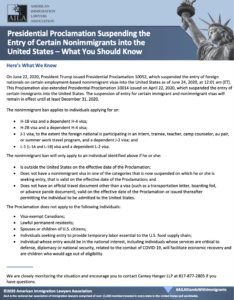In the August “check-in,” Charlie describes the movement in each category which is readily apparent from looking at the Visa Bulletin. Charlie’s predictions on future movement of the visa categories are few:
· F2A is expected to remain current in September and October.
· EB-1 Worldwide (including El Salvador, Guatemala and Honduras, Mexico Philippines and Vietnam) will continue to remain current through the end of this fiscal year.
· While there is still potential for forward movement in EB-1 China and EB-1 India in September, any advance movements are unlikely to be as dramatic as in August.
· EB-2 Worldwide (including El Salvador, Guatemala and Honduras, Mexico Philippines and Vietnam) will remain current through this fiscal year. EB-2 China advances approximately nine weeks from November 8, 2015 to January 15, 2016. In contrast, EB-2 India holds at July 8, 2009 in August. It is currently estimated that there is a sufficient amount of worldwide demand to reach or approximate the EB-2 annual limit for FY2020.

